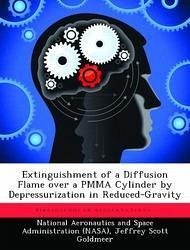Extinction of a diffusion flame burning over horizontal PMMA (Polymethyl methacrylate) cylinders in low-gravity was examined experimentally and via numerical simulations. Low-gravity conditions were obtained using the NASA Lewis Research Center's reduced-gravity aircraft. The effects of velocity and pressure on the visible flame were examined. The flammability of the burning solid was examined as a function of pressure and the solid-phase centerline temperature. As the solid temperature increased, the extinction pressure decreased, and with a centerline temperature of 525 K, the flame was sustained to 0.1 atmospheres before extinguishing. The numerical simulation iteratively coupled a two-dimensional quasi-steady, gas-phase model with a transient solid-phase model which included conductive heat transfer and surface regression. This model employed an energy balance at the gas/solid interface that included the energy conducted by the gas-phase to the gas/solid interface, Arrhenius pyrolysis kinetics, surface radiation, and the energy conducted into the solid. The ratio of the solid and gas-phase conductive fluxes Phi was a boundary condition for the gas-phase model at the solid-surface. Initial simulations modeled conditions similar to the low-gravity experiments and predicted low-pressure extinction limits consistent with the experimental limits. Other simulations examined the effects of velocity, depressurization rate and Phi on extinction.
Bitte wählen Sie Ihr Anliegen aus.
Rechnungen
Retourenschein anfordern
Bestellstatus
Storno








